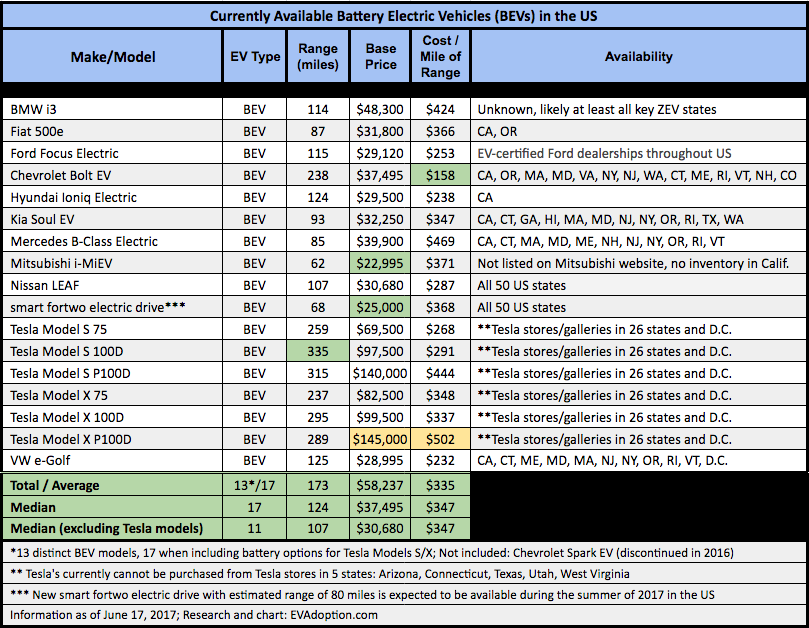The median range across the 13* currently available battery electric vehicles (BEVs) is 124 miles, while the average battery range is 173 miles, based on some new EVAdoption analysis. The average base price across the BEVs is $58,237 and median price is $37,495.
The highest range of a non Tesla is of course GM’s Chevrolet Bolt at 238 miles. In a landslide, the Bolt takes the top prize for the lowest cost per mile of range at $158. The $145,000 high-performance Tesla Model S P100D not surprisingly has the highest cost per mile of range at $502.
If the Tesla models (Tesla remains the only manufacturer with more than one BEV available in the US* – Models S and X) are excluded, the median range drops to 107 miles and a median cost of $30,680. Median cost per mile actually increases $10 when the Tesla models are excluded.
The Tesla Model S 100D has the highest battery range at 335 miles. The Mitsubishi i-MiEV and smart fortwo electric drive pull up the rear with 62 and 68 miles respectively. (Note: A new version of the smart fortwo electric drive with an estimated 80 miles of range is expected to reach US shores in the summer of 2017.)
Of the 13 models, three have a range of greater than 200 miles and five have less than 100 miles of range, both of which are fairly strong psychological barriers for American consumers.
Here is what we do and don’t know about the future of the five with under 100 miles of range:
- Mitsubishi i-MiEV**: The car seems to be either dead or dying in the US.
- Fiat 500e: With parent FCA not believing in or investing much in EV technology, the 87-miles of range is likely to not change for awhile.
- smart fortwo ED: With a bump up to about 80 miles of range in the summer of 2017, we might see the car top 100 miles in late 2018.
- Kia Soul EV: According to Electrek, the 2018 Soul should see a slightly larger battery pack and increased range to about 105-110 miles.
- Mercedes B-Class Electric: With Mercedes focusing on the launch of its EQ electric vehicle sub-brand around 2020, we might not see a larger battery back soon, if ever, in this model.
With these above battery changes in mind, and factoring in the launches in 2017 and 2018 of the Tesla Model 3, a longer-range Nissan LEAF, the Jaguar i-PACE and some incremental range increases in other BEVs, by the end of 2018 we should see both the average and median range of BEVs available in the US at or near 200 miles.
Note: Thanks to my awesome research assistant (daughter Laura) for building out the above chart.
(*As reader Brandon Smoker pointed out to me, Nissan makes the eNV-200 electric van, but it is not currently available in the US.)
(**The Mitsubishi i MiEV is not listed on the Mitsubishi website and according to InsideEVs, the car sold zero units in May of 2017 and only 6 total in 2017. We will try to verify the availability status in the coming weeks.)


